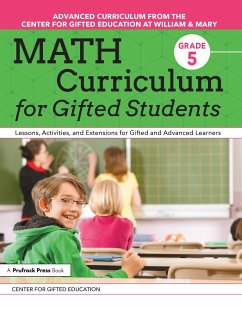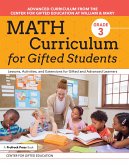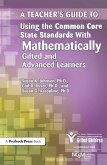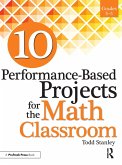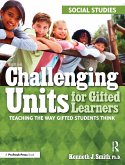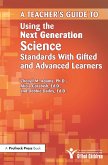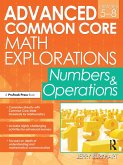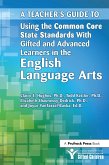Center for Gifted Education
Math Curriculum for Gifted Students
Lessons, Activities, and Extensions for Gifted and Advanced Learners: Grade 5
Center for Gifted Education
Math Curriculum for Gifted Students
Lessons, Activities, and Extensions for Gifted and Advanced Learners: Grade 5
- Broschiertes Buch
- Merkliste
- Auf die Merkliste
- Bewerten Bewerten
- Teilen
- Produkt teilen
- Produkterinnerung
- Produkterinnerung
In Math Curriculum for Gifted Students (Grade 5), the 20 lessons cover mathematics content for grade 5 and are divided into five sections: number and operations in Base Ten, operations and algebraic thinking, number and operations-fractions, measurement and data, and geometry.
Andere Kunden interessierten sich auch für
![Math Curriculum for Gifted Students Math Curriculum for Gifted Students]() Centre for Gifted EducationMath Curriculum for Gifted Students40,99 €
Centre for Gifted EducationMath Curriculum for Gifted Students40,99 €![A Teacher's Guide to Using the Common Core State Standards with Mathematically Gifted and Advanced Learners A Teacher's Guide to Using the Common Core State Standards with Mathematically Gifted and Advanced Learners]() National Assoc For Gifted ChildrenA Teacher's Guide to Using the Common Core State Standards with Mathematically Gifted and Advanced Learners23,99 €
National Assoc For Gifted ChildrenA Teacher's Guide to Using the Common Core State Standards with Mathematically Gifted and Advanced Learners23,99 €![10 Performance-Based Projects for the Math Classroom 10 Performance-Based Projects for the Math Classroom]() Todd Stanley10 Performance-Based Projects for the Math Classroom36,99 €
Todd Stanley10 Performance-Based Projects for the Math Classroom36,99 €![Challenging Units for Gifted Learners Challenging Units for Gifted Learners]() Kenneth J SmithChallenging Units for Gifted Learners36,99 €
Kenneth J SmithChallenging Units for Gifted Learners36,99 €![Teacher's Guide to Using the Next Generation Science Standards with Gifted and Advanced Learners Teacher's Guide to Using the Next Generation Science Standards with Gifted and Advanced Learners]() Cheryll M AdamsTeacher's Guide to Using the Next Generation Science Standards with Gifted and Advanced Learners23,99 €
Cheryll M AdamsTeacher's Guide to Using the Next Generation Science Standards with Gifted and Advanced Learners23,99 €![Advanced Common Core Math Explorations Advanced Common Core Math Explorations]() Jerry BurkhartAdvanced Common Core Math Explorations42,99 €
Jerry BurkhartAdvanced Common Core Math Explorations42,99 €![A Teacher's Guide to Using the Common Core State Standards with Gifted and Advanced Learners in the English Language Arts A Teacher's Guide to Using the Common Core State Standards with Gifted and Advanced Learners in the English Language Arts]() National Assoc For Gifted ChildrenA Teacher's Guide to Using the Common Core State Standards with Gifted and Advanced Learners in the English Language Arts23,99 €
National Assoc For Gifted ChildrenA Teacher's Guide to Using the Common Core State Standards with Gifted and Advanced Learners in the English Language Arts23,99 €-
-
-
In Math Curriculum for Gifted Students (Grade 5), the 20 lessons cover mathematics content for grade 5 and are divided into five sections: number and operations in Base Ten, operations and algebraic thinking, number and operations-fractions, measurement and data, and geometry.
Hinweis: Dieser Artikel kann nur an eine deutsche Lieferadresse ausgeliefert werden.
Hinweis: Dieser Artikel kann nur an eine deutsche Lieferadresse ausgeliefert werden.
Produktdetails
- Produktdetails
- Verlag: Taylor & Francis Ltd (Sales)
- 2nd edition
- Seitenzahl: 192
- Erscheinungstermin: 1. April 2020
- Englisch
- Abmessung: 277mm x 213mm x 15mm
- Gewicht: 454g
- ISBN-13: 9781618219947
- ISBN-10: 1618219944
- Artikelnr.: 58124583
- Herstellerkennzeichnung
- Libri GmbH
- Europaallee 1
- 36244 Bad Hersfeld
- gpsr@libri.de
- Verlag: Taylor & Francis Ltd (Sales)
- 2nd edition
- Seitenzahl: 192
- Erscheinungstermin: 1. April 2020
- Englisch
- Abmessung: 277mm x 213mm x 15mm
- Gewicht: 454g
- ISBN-13: 9781618219947
- ISBN-10: 1618219944
- Artikelnr.: 58124583
- Herstellerkennzeichnung
- Libri GmbH
- Europaallee 1
- 36244 Bad Hersfeld
- gpsr@libri.de
The Center for Gifted Education at The College of William and Mary, a research and development center, was established in 1988 under the direction of Dr. Joyce VanTassel-Baska. The center provides services to educators, policy makers, graduate students, researchers, parents, and students in support of the needs of gifted and talented individuals. Located in Williamsburg, VA, the center has established a national reputation for excellence in research, curriculum development, and service. Several major grants, including funding from the Jacob K. Javits Gifted and Talented Students Education Act, have provided significant support for the work of the Center. Margaret Jess McKowen Patti is a third- and fourth-grade teacher of gifted students at Zachary Elementary School in Louisiana, where she recently received the Zachary Community School District Teacher of the Year.
"Introduction Section I: Operations and Algebraic Thinking Lesson 1.1:
Writing and Interpreting Numerical Expressions Lesson 1.2: Analyzing
Patterns and Relationships Section II: Number and Operations in Base Ten
Lesson 2.1: Placing Value Lesson 2.2: Patterns in Number of Zeros and
Whole-Number Exponents Lesson 2.3: Read, Write, and Compare Decimals Lesson
2.4: Modeling Whole-Number Multiplication and Division Lesson 2.5: Modeling
Decimals Through Operations Section III: Number and Operations-Fractions
Lesson 3.1: Adding and Subtracting Fractions With Unlike Denominators and
Word Problems Lesson 3.2: Interpreting Fraction as Division and Solving
Word Problems With Division to Get Mixed Numbers Lesson 3.3: Parts of a
Partition Lesson 3.4: Finding the Area Lesson 3.5: Products of Fractions
and Mixed Numbers Lesson 3.6: Interpreting Division of Unit Fractions and
Whole Numbers in Real-World Problems Section IV: Measurement and Data
Lesson 4.1: Converting Standard Measurement Units Lesson 4.2: Representing
Measurements on Line Plots Lesson 4.3: Recognizing and Measuring Volume
Lesson 4.4: Finding Volume and Applying the Formula Lesson 4.5: Recognizing
Volume as Additive Section V: Geometry Lesson 5.1: Graphing Coordinates to
Represent Real-World Problems Lesson 5.2: Classifying Figures Answer Key
About the Authors About the Center for Gifted Education Common Core State
Standards Alignment
"
Writing and Interpreting Numerical Expressions Lesson 1.2: Analyzing
Patterns and Relationships Section II: Number and Operations in Base Ten
Lesson 2.1: Placing Value Lesson 2.2: Patterns in Number of Zeros and
Whole-Number Exponents Lesson 2.3: Read, Write, and Compare Decimals Lesson
2.4: Modeling Whole-Number Multiplication and Division Lesson 2.5: Modeling
Decimals Through Operations Section III: Number and Operations-Fractions
Lesson 3.1: Adding and Subtracting Fractions With Unlike Denominators and
Word Problems Lesson 3.2: Interpreting Fraction as Division and Solving
Word Problems With Division to Get Mixed Numbers Lesson 3.3: Parts of a
Partition Lesson 3.4: Finding the Area Lesson 3.5: Products of Fractions
and Mixed Numbers Lesson 3.6: Interpreting Division of Unit Fractions and
Whole Numbers in Real-World Problems Section IV: Measurement and Data
Lesson 4.1: Converting Standard Measurement Units Lesson 4.2: Representing
Measurements on Line Plots Lesson 4.3: Recognizing and Measuring Volume
Lesson 4.4: Finding Volume and Applying the Formula Lesson 4.5: Recognizing
Volume as Additive Section V: Geometry Lesson 5.1: Graphing Coordinates to
Represent Real-World Problems Lesson 5.2: Classifying Figures Answer Key
About the Authors About the Center for Gifted Education Common Core State
Standards Alignment
"
"Introduction Section I: Operations and Algebraic Thinking Lesson 1.1:
Writing and Interpreting Numerical Expressions Lesson 1.2: Analyzing
Patterns and Relationships Section II: Number and Operations in Base Ten
Lesson 2.1: Placing Value Lesson 2.2: Patterns in Number of Zeros and
Whole-Number Exponents Lesson 2.3: Read, Write, and Compare Decimals Lesson
2.4: Modeling Whole-Number Multiplication and Division Lesson 2.5: Modeling
Decimals Through Operations Section III: Number and Operations-Fractions
Lesson 3.1: Adding and Subtracting Fractions With Unlike Denominators and
Word Problems Lesson 3.2: Interpreting Fraction as Division and Solving
Word Problems With Division to Get Mixed Numbers Lesson 3.3: Parts of a
Partition Lesson 3.4: Finding the Area Lesson 3.5: Products of Fractions
and Mixed Numbers Lesson 3.6: Interpreting Division of Unit Fractions and
Whole Numbers in Real-World Problems Section IV: Measurement and Data
Lesson 4.1: Converting Standard Measurement Units Lesson 4.2: Representing
Measurements on Line Plots Lesson 4.3: Recognizing and Measuring Volume
Lesson 4.4: Finding Volume and Applying the Formula Lesson 4.5: Recognizing
Volume as Additive Section V: Geometry Lesson 5.1: Graphing Coordinates to
Represent Real-World Problems Lesson 5.2: Classifying Figures Answer Key
About the Authors About the Center for Gifted Education Common Core State
Standards Alignment
"
Writing and Interpreting Numerical Expressions Lesson 1.2: Analyzing
Patterns and Relationships Section II: Number and Operations in Base Ten
Lesson 2.1: Placing Value Lesson 2.2: Patterns in Number of Zeros and
Whole-Number Exponents Lesson 2.3: Read, Write, and Compare Decimals Lesson
2.4: Modeling Whole-Number Multiplication and Division Lesson 2.5: Modeling
Decimals Through Operations Section III: Number and Operations-Fractions
Lesson 3.1: Adding and Subtracting Fractions With Unlike Denominators and
Word Problems Lesson 3.2: Interpreting Fraction as Division and Solving
Word Problems With Division to Get Mixed Numbers Lesson 3.3: Parts of a
Partition Lesson 3.4: Finding the Area Lesson 3.5: Products of Fractions
and Mixed Numbers Lesson 3.6: Interpreting Division of Unit Fractions and
Whole Numbers in Real-World Problems Section IV: Measurement and Data
Lesson 4.1: Converting Standard Measurement Units Lesson 4.2: Representing
Measurements on Line Plots Lesson 4.3: Recognizing and Measuring Volume
Lesson 4.4: Finding Volume and Applying the Formula Lesson 4.5: Recognizing
Volume as Additive Section V: Geometry Lesson 5.1: Graphing Coordinates to
Represent Real-World Problems Lesson 5.2: Classifying Figures Answer Key
About the Authors About the Center for Gifted Education Common Core State
Standards Alignment
"

